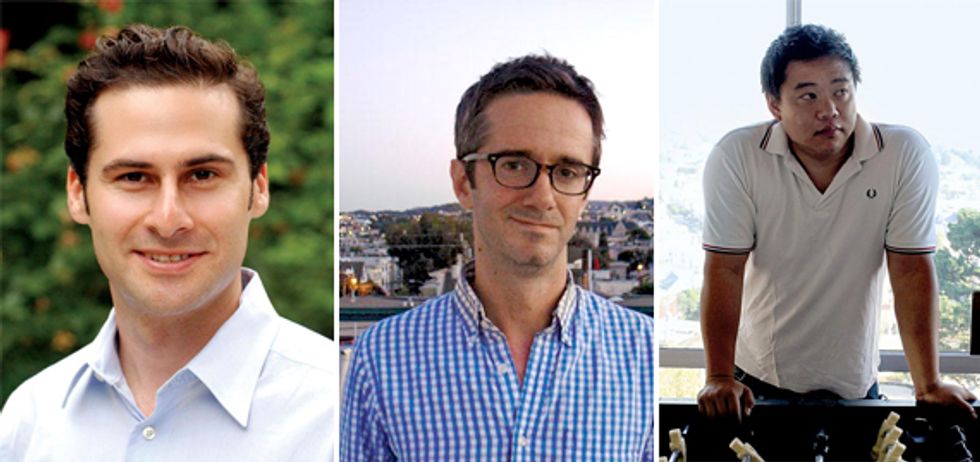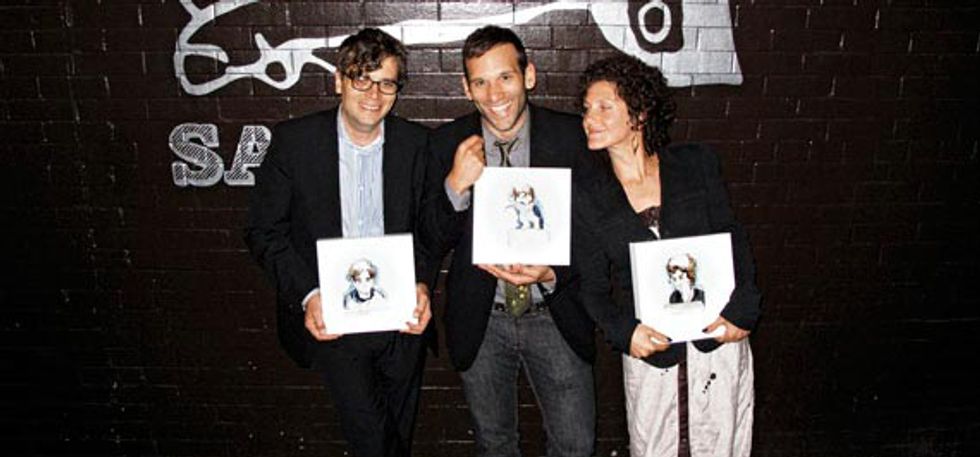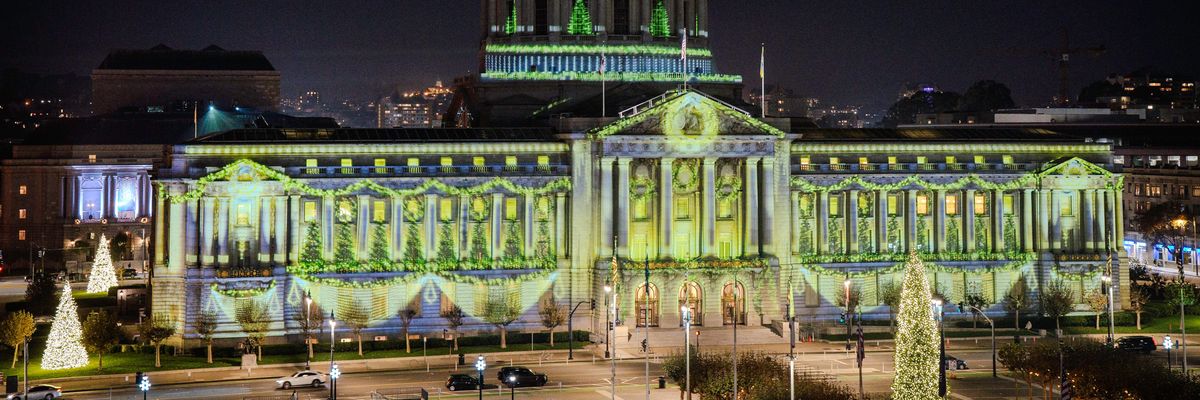It’s a Thursday night, and the Herbst Theatre is buzzing with people, including a disproportionate number of 20- and 30-somethings sporting some article of vintage attire. It seems as though the entire San Francisco writing community is here. There’s the creative director of Mother Jones, a couple of Wired editors, The New Yorker writers, and folks from McSweeney’s and Salon. Up front are the speakers for tonight, including The New York Times best-selling author Mary Roach (of Packing for Mars, Stiff, Spook, and Bonk) and The Vagrants and Gold Boy, Emerald Girl author Yiyun Li (recently named one of The New Yorker’s top 20 fiction writers under 40). Later, the rebel editors of Longshot magazine walk by. The audience is breathless, as if it knows something special is about to happen, and everyone here is a lucky witness. After all, what kind of literary event sells out as quickly as an Arcade Fire concert?
Pop-Up Magazine’s Issue Four did. In 15 minutes, some 900 people bought up every ticket, fighting their way through endless busy signals and an online box office—all to sit here and watch the city’s best writers, editors, and filmmakers perform onstage. It’s a salon-style event, a stunt really. A magazine come to life. There are no cameras allowed so that it becomes something truly live, undocumented, and unrepeatable. No one knows when editor in chief Douglas McGray, an established writer at The Atlantic, The New Yorker, and NPR’s This American Life will “publish” the next one. Considering we’re in an era when magazines and newspapers fear the fast approach of Doomsday, it’s thrillingly idealistic.
The scene was much the same at Pop-Up’s first issue, in April 2009, held at the Mission’s funky Brava Theater. That night, a smaller crowd gathered by word of mouth to see Michael Pollan alongside The New York Times Magazine writer Peggy Orenstein, among others. The second issue six months later had a new lineup and sold out even faster than the first. By the time the fourth issue came around, Pop-Up had gained a following on Twitter and Facebook, and McGray moved his “newsstand” to the significantly larger Herbst.
The chatter at Issue Four quiets as the lights dim. A projector flashes “Letters” on a screen, and a spotlight shines down on Roach at the podium. She shuffles through a stack of letters she’s received from fans. Many of them are crackpot—perfect for Pop-Up. Roach delivers them with the deadpan humor and casualness you’d expect at a dinner party. Reviews of booze gadgets from Steven Leckart of Wired follow, Novella Carpenter tells a hysterical tale of a primitive living gathering, and Yiyun Li deconstructs the word “eavesdropping.” The crowd—many of them writers or aspiring writers—take it in hook, line, and sinker. They’re hungry for a sign that publishing is indeed not dead, something Pop-Up seems to promise.
Left to Right: Hacks/Hackers’ Burt Herman; Pop-Up Magazine’s Douglas McGray; Chris Ying of McSweeney’s.
New York might be ground zero for publishing, but SF has historically been a breeding ground for unconventional publications, from Wired and McSweeney’s Quarterly Concern to Salon, one of the first general interest online magazines. The writers community here is prominent. The Bay Area is a draw for all sorts of nationally acclaimed authors: Michael Chabon, Michael Lewis, Amy Tan, Tobias Wolff, Dave Eggers. Even Jonathan Franzen lives part-time in Santa Cruz.
But in 2009, the publishing world as we know it—which was already stumbling—was hit by the recession. The country lost 86,800 print jobs. Magazines like Gourmet and Domino closed, and weekly circulation at the San Francisco Chronicle fell more than 25 percent. By the end of 2009, the paper’s staff was at 40 percent of what it was the year before. Even promising hybrid startups folded—JPG Magazine (a photo-driven, crowd-sourced print model) closed the same month Bank of America received a federal bailout. All this left a bevy of unemployed writers and editors searching for work—and a lot of pent-up creative energy.
Meanwhile, the Bay Area continued to produce cutting-edge media platforms—Twitter exploded, the iPad was introduced. Yet, some of the old regime is not having it. “If you’re hearing few howls and seeing little rending of garments over the impending death of institutional, high-quality journalism, it’s because the public at large has been trained to undervalue journalists and journalism,” wrote McGray’s fellow writer at The Atlantic, Michael Hirschorn, in the magazine at the beginning of 2009. “The Internet has done much to encourage lazy news consumption, while virtually eradicating the meaningful distinctions among newspaper brands.” To this end, in a report released this past June, the Federal Trade Commission debated policy reform to help journalism reinvent itself, noting that blogs and online aggregators have made it difficult to convince readers that original stories from established publications are worth paying for.
But there’s a growing group of local writers who are tired of waiting around for things to improve and they’ve decided to take advantage of the same technology that supposedly threatens the very existence of print. “San Francisco has always been a place for experimentation,” says Alexis Madrigal, cofounding editor of Longshot, a general interest magazine edited and designed in 48 hours by a volunteer staff—many of them interns and editors at more traditional publications. “It’s a well-read city, plus there’s
the tech scene. Technology’s the future for publishing and journalism. Longshot was an experiment to see if we could do it on our own and over the weekend.” Which is exactly what they did in May, when they took over the old Rolling Stone conference table in the Mother Jones offices. “Being in that space, at that table was like, come on, this has to be a blessing or leftover good karma, right?” says Madrigal.
Mathew Honan, Alexis Madrigal, and Sarah Rich at the Longshot magazine Issue One launch afterparty.
The idea was to produce a print magazine—but one that embraces the Internet by streaming live video of the editorial process, taking advantage of print-on-demand publishing from MagCloud. The Hewlett-Packard service lets Madrigal (or anyone for that matter) upload a PDF file to the MagCloud site, which in turn prints and ships copies to readers directly. Initially, Madrigal, along with his girlfriend, former Dwell senior editor Sarah Rich, and Wired contributing writer Mathew Honan (also a contributor to 7x7), operated under the name 48 HR Magazine until CBS threatened to sue for trademark infringement shortly after the first issue came out. The theme the editors settled on for that issue was “Hustle,” which certainly resonated with the freelance writers who contributed.
Once news outlets such as the Los Angeles Times and the The Wall Street Journal got wind of the concept, it took off. In the end, the editors received 1,500 submissions of essays, poetry, photos, and reported stories—and even some porn—from as far away as London. This summer, the group received a Knight-Batten Award for Innovations in Journalism and wrapped up its sophomore issue, themed “Comeback”— which combined irreverent sidebars, trend pieces (on the return of bacon, for instance), and a deadpan review of yo-mama jokes into a compilation that reads somewhere between The New York Times Magazine, Esquire, and a really good college journal. “Last time, there were more disagreements,” says Madrigal of the first issue. “There was more coffee and whiskey but no sleep.”
Longshot wouldn’t have been possible without new publishing technology, which is exactly what Burt Herman, a former AP foreign correspondent, wanted to take advantage of when he created Hacks/Hackers. He formed the group on Meetup.com to organize panels that explored how journalists and web developers can unite to help shape the future of news. Two weeks after the first issue of Longshot debuted in May, Herman hosted 80 writers and developers to form teams and collaborate on news apps for the iPad over two days. “Journalists believe in and want to tell stories, and developers want to solve problems,” he says. “They share a common drive.”
One group set out to cover Harvey Milk Day as a special, interactive newspaper section readers could download as an app. While the team’s journalists hit the streets reporting, the tech side built, designed, and coded the app. When the reporters returned, they rejoined their teammates in sweaty concentration among cans of Coke and half-eaten boxed lunches. At the end of the hack fest, teams unveiled everything from a news quiz game to a web app that detects your location and displays articles about local congressmen. Herman has since held hack days in New York, Boston, Chicago, and LA, and has future sessions planned at newly formed chapters in Austin and Washington, DC.
While Pop-Up, Longshot, and Hacks/Hackers are looking forward, the folks over at McSweeney’s spent a good part of last year looking back, to the days when newspapers were king and morning and evening editions had broadsheets the wingspan of an owl. The kind of design that went into those papers was something that Chris Ying, McSweeney’s publisher, obsessed over when he helped create Panorama. Ying describes the 300-plus-page, one-day only newspaper, which was released on Dec. 8, as “a labor of love and a tribute to all of the newspapers that I and the staff look up to, from places that have a real newspaper culture.” That list includes South China Morning Post, Daily Zaman, Bangkok Post, and Gulf News. Ying’s team also looked to the past. “The New York World, for example, [published from 1860–1931] had these lavishly, amazingly hand-laid spreads,” says Ying. “That was something we wanted to do.” To put their 21st-century stamp on an old-fashioned paper, they assigned stories and illustrations out to Stephen King, James Franco, and their favorite sports bloggers, and they took inspiration from 4505 Meats Ryan Farr for recipes they photographed step-by-step in the food section.
That first and only issue, distributed in the streets of San Francisco and in bookstores elsewhere, sold out its 20,000 copies in a little more than a week. “In a country where we’re being told that newspapers are dying, we had people in San Francisco stopping us while we were unloading the trucks because they wanted to buy the paper,” says Ying. “I think people were excited about a newspaper that has content. We immediately had to do another print run. We’ve sold 40,000 all told, but people are still requesting them nine months later.” Since San Franciscans are, by nature, a little nutty for all things small-batch, hand-crafted, and archival, it begs the question: Did Panorama sell out twice because it was a great newspaper or because it was a rare artifact?
The more important point might be that it got people talking—on both coasts. “There’s a lot of visual creativity and exciting new technology coming out of San Francisco,” says New York Times multimedia editor and SF native Andrew DeVigal, who admits that he’s a little envious of his hometown, where concepts such as Pop-Up and Panorama are being born. Running a magazine in SF longterm is another matter though. Publications that go big, such as Rolling Stone and ReadyMade, often relocate to New York. Even Longshot set up shop in LA for its last issue (the team hopes to crash a new city for each issue from here on out).
But even if it doesn’t begin and end here, by inspiration alone, San Francisco is pushing publishing forward. After Panorama debuted, similar startups—including SF Public Press and This Land out of Tulsa—took a cue from Ying and his team to produce their own reinvented newspaper. And tech-driven creatives from New York to Europe are collaborating with artists, web developers, and writers to build future versions of magazines and newspapers: the upcoming phone-and-tablet-based magazine The Atavist; food zine Put A Egg On It; crowd-sourced and -funded (on Kickstarter.com) Remedy Quartlery; London-based Monocle Mediterraneo; and the round, design-oriented, semi-annual Freestyle Magazine, produced in Berlin and packaged inside a Frisbee.
Amid all the excitement, though, the elephant in the room is the basic fact that not one of these publications has clear plans for future issues, advertising, or sustainable business models. Not yet, anyway. But if anyone can figure out the business end of the new publishing paradigm, it just might be Michael Maness, the vice president of design and innovation at media conglomerate Gannett, which publishes USA Today. Last fall, Maness chose San Francisco as the home of Gannett’s unconventional project, The Bold Italic, a magazine-like website that asks its writers, called Bold Locals, to tell their personal stories of discovering people, places, and scenes within San Francisco. Gannett chose to launch the Bold Italic here for a reason. “From a digital lifestyle perspective,” says Maness, “if you can stay abreast of what goes on in San Francisco and what people want to read here, then you’re going to be ahead of the curve.”
The Bold Italic hosts bimonthly microhood get-togethers around the city, the ticket sales from which partially fund the articles they publish. The site is clear of ads, and its first-person stories are read by 20,000 unique visitors a month—not a bad number for an online niche publication. Maness says, “This could be the prototype we’ve been looking for.”
If The Bold Italic—or Longshot or Pop-Up for that matter—proves to be sustainable in the long run, it won’t be the first time a new media paradigm has emerged from the Bay Area (just ask the founders of Google). For publishing to survive, it needs the kind of idealists and experiments that this city cultivates. Inevitably, San Francisco’s expanding new-media test kitchen will produce something that sticks. When it does, you can say you were there.























